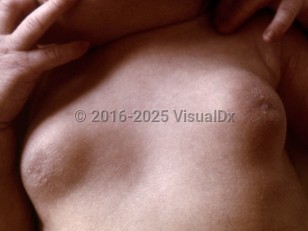Physiologic breast engorgement of newborn
Alerts and Notices
Important News & Links
Synopsis

Maternal estrogens circulating during pregnancy can cross the placenta and cause breast enlargement of the developing fetus. Breast enlargement can be obvious at birth or several days within delivery of the newborn. Breast enlargement is short lived and should decrease to normal within 2 weeks after birth. Both boys and girls can be affected.
Codes
ICD10CM:
P83.4 – Breast engorgement of newborn
SNOMEDCT:
34831003 – Breast engorgement in newborn
P83.4 – Breast engorgement of newborn
SNOMEDCT:
34831003 – Breast engorgement in newborn
Look For
Subscription Required
Diagnostic Pearls
Subscription Required
Differential Diagnosis & Pitfalls

To perform a comparison, select diagnoses from the classic differential
Subscription Required
Best Tests
Subscription Required
Management Pearls
Subscription Required
Therapy
Subscription Required
References
Subscription Required
Last Updated:12/15/2021
Physiologic breast engorgement of newborn

